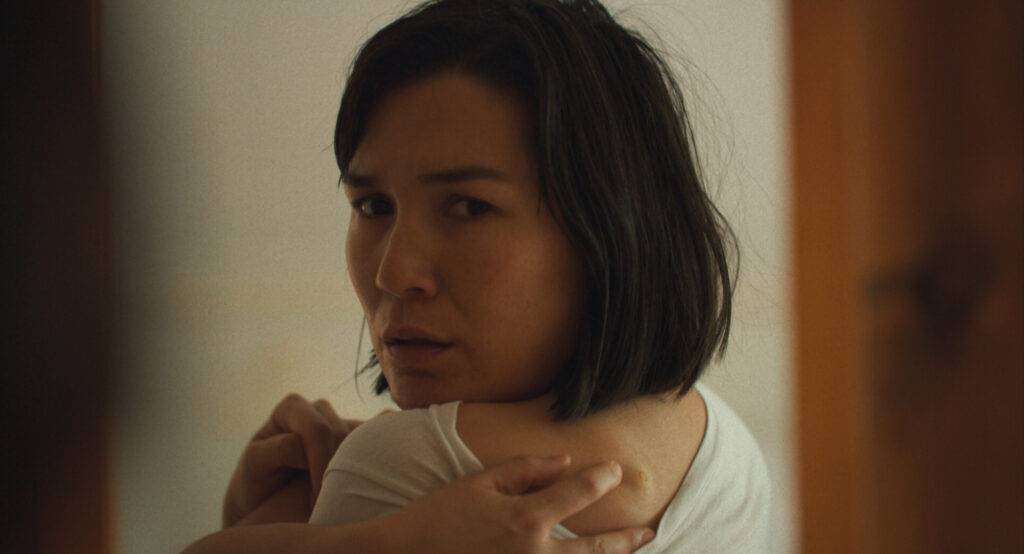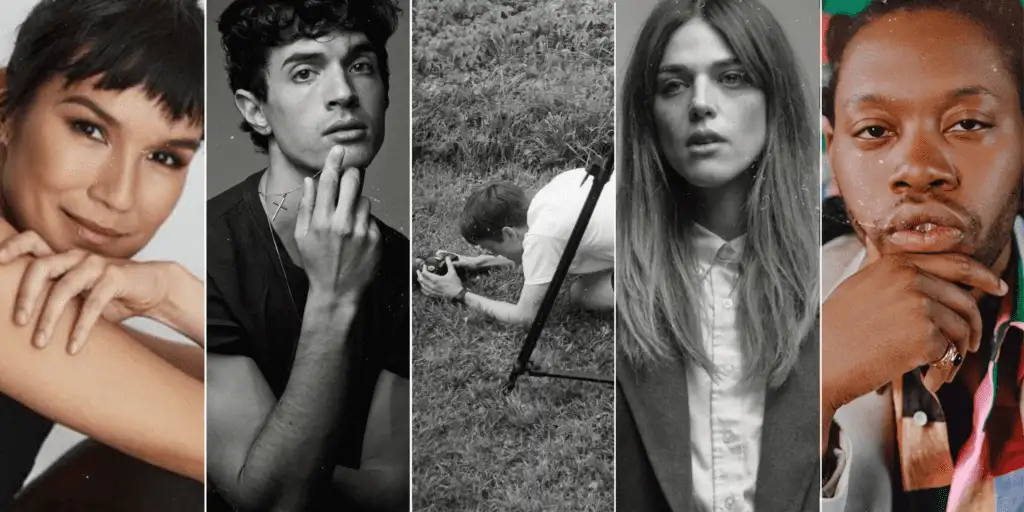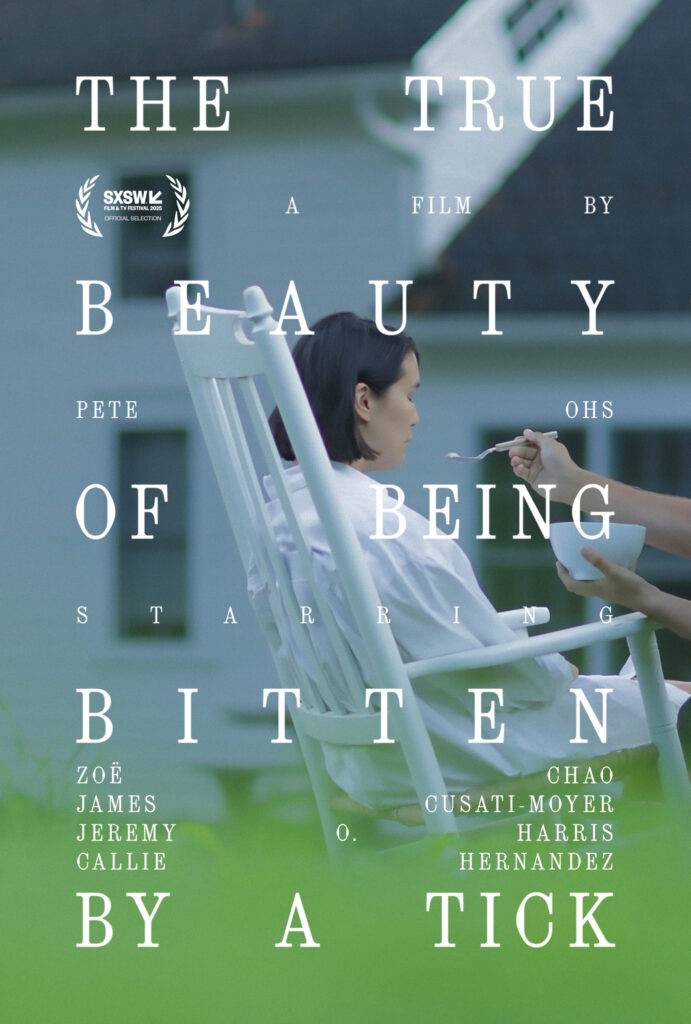At the Table of Bubbles: Pete Ohs and the Cast of THE TRUE BEAUTY OF BEING BITTEN BY A TICK

The True Beauty of Being Bitten By a Tick Still with Chloe Zhao | Courtesy of Exile PR
Premiering at SXSW 2025, The True Beauty of Being Bitten by a Tick is a film that defies easy categorization. It begins as a retreat – a woman named Yvonne (Zoë Chao) visits her friend Camille (Callie Hernandez) in a picturesque, rural home, hoping to escape personal grief. There, she meets two of Camille’s enigmatic friends, A.J. (James Cusati-Moyer) and Isaac (Jeremy O. Harris). They drink wine, eat fresh produce, and indulge in carefully curated leisure. But when Yvonne is bitten by a tick, time itself begins to warp. A weekend away becomes something else entirely – something eerie, funny, and existentially unnerving.
What is The True Beauty of Being Bitten By a Tick?
When I sit down with Pete Ohs and the cast of The True Beauty of Being Bitten by a Tick, it’s late in the day. They’ve been talking about this film for hours, moving from one press interview to the next, yet somehow, once we start discussing collaboration and creative freedom, their energy shifts. Sleepy eyes brighten. The conversation becomes less about promoting a movie and more about why they make them in the first place.
Much like the film itself, the process behind Tick is both methodical and spontaneous. Ohs, who has built a reputation for crafting micro-budget indies (Jethica, Youngstown), describes his approach not as “directing” in the traditional sense, but more about creating the conditions for something worthwhile to emerge.
As someone who often feels trapped in the cycle of creating a “product,” it’s difficult to not find the approach of The True Beauty of Being Bitten by a Tick refreshing.
Pete Ohs and Coming Together as Collaborators
Pete Ohs doesn’t see himself as a singular auteur. If anything, he resists that notion entirely. “I think it’s cool that I’m a director saying I’m not the genius – we are all the genius, and it’s not even within us; it’s outside of us,” he says. For him, filmmaking isn’t about control. It’s about setting something in motion and letting the right people shape it into something unexpected.
That philosophy extends to his process, which he describes as intuitive and ongoing. “This is my preferred way to make a movie,” he explains. “It’s how I’ve been doing it for several movies now. Basically, I’ve been making a movie a year. When the new year starts, I ask myself, ‘What’s going to be the 2023 movie? What’s going to be the 2024 movie?’”
I didn’t want to be a ‘normal’ filmmaker who writes a script and tells everyone what to do – Pete Ohs
For The True Beauty of Being Bitten by a Tick, one of Ohs’ “2024 movies,” the idea came about when he visited Callie Hernandez at the house she was renting. “I had rented the house for a year, and this was the first film we made,” Hernandez recalls. “Pete came over, we looked outside, and we thought, ‘Oh wow, look at that beautiful field. What do we see? Ticks.’ That’s how it happened.”
That offbeat discovery set the stage for a film that would embrace uncertainty rather than resist it. “Filmmaking is a collaborative medium, but the way we’re doing it is even more collaborative,” Ohs says. “It starts with a small idea and then grows through conversations about what we want to do. There’s a bit of me starting it, getting the fire going, but everyone else adds kindling and helps build the flame. They bring their ideas and opinions at every step. This challenges the auteur theory of filmmaking.”
That challenge is what Jeremy O. Harris found so compelling. He joined the project after Ohs edited his HBO documentary Slave Play. Not a Movie. A Play., and immediately recognized the power of this approach. “One thing that’s funny – is that in the Greek understanding, genius isn’t something you are; it’s something that visits you,” Harris says. “I love that you [Pete] brought that into the space.”
Shared Screenwriting Credits and Organic Creation

(L-R) Zoë Chao, James Cusati-Moyer, Pete Ohs, Callie Hernandez, Jeremy O. Harris | Photo Credits: Pete Thompson, Emil Cohen, Jesse Reed, Jacob Boll, Micaiah Carter
Rather than adhering to a rigid, top-down creative structure, Ohs’ process functioned more like an open forum – one where every voice had weight, but the film itself dictated what belonged. “Collaborating in this way was so freeing and fun,” Harris continues. “There was a lot of ‘yes,’ but also a lot of ‘Well, I don’t think it’s that.’ We’re all like staff writers, but Pete is truly the author. He would hear ideas and say, ‘That’s Tick,’ or ‘That’s not Tick, that’s a different movie.’
But it wasn’t just about collaboration – it was about trust. “It’s organic in that we set intentions but let discoveries find us,” Pete added. That openness gave the film a natural rhythm – one that made every moment feel lived-in rather than manufactured. Despite this openness, Pete Ohs still had a clear vision for The True Beauty of Being Bitten by a Tick. Instead of dictating every detail, though, he created a framework where the cast could bring their own voices into the world.
If you’re not doing it for a big paycheck but to disrupt something or wake something up inside yourself, that’s worth doing. That’s what the table of bubbles brought for me – a reminder of why I make things – Jeremy O. Harris
For James Cusati-Moyer, that meant grounding his performance in small, lived-in details. “What I contribute is specific facts or details about human behavior around the house, caretaking, and food. Spring onions, for instance,” he says. The actors weren’t just delivering lines – they were shaping the texture of the film.
Food, in particular, became an anchor. The characters fixate on it – discussing produce like it’s sacred, preparing meals with obsessive care, finding comfort in routine. But as the film progresses, these moments start to feel uneasy. The ritual of eating, once warm and communal, turns exaggerated, distorted. The camera lingers too long on chewing, the sounds become grotesque, and what once felt like a simple dinner table conversation starts to feel like something more sinister.
That balance – between naturalism and creeping unease – is what made the process so effective. Jeremy O. Harris describes it best: “It’s not improvised… It’s measured, and we write everything. But because it’s already in our voices, we’re more free to play.” Scenes were crafted carefully, but they retained a looseness that allowed for discovery.
Rather than working against the film’s themes, this approach enhanced them. Tick is about the slow unraveling of control – about how even the most structured environments can become unsettling. By letting the actors shape their characters in ways that felt natural, the film makes that tension feel lived-in, rather than forced.
The Table of Bubbles Philosophy
What makes The True Beauty of Being Bitten by a Tick remarkable isn’t just its themes or visuals – it’s the way it exists at all. Made on a small budget, with a skeletal crew, in a rented house, the film embodies the kind of indie filmmaking that feels increasingly rare.
Harris sees this kind of risk-taking as essential. “It’s not about waiting for millions of dollars,” he says. “In three months, working your normal job and checking Airbnb deals, you can make a movie with your friends and end up at a major festival like South by Southwest, Sundance, or Locarno.”
For Ohs, this process is about letting go of expectation. “The table of bubbles is a metaphor I apply to this process of making films,” he explains. “Imagine a table made of bubbles – it’s beautiful and magical, but it can’t support anything. Don’t put your plates or forks on it, and don’t put your hopes, dreams, or expectations on it either.”
There are a million and one ways to make a movie. Sometimes they work, and sometimes they don’t… but experimenting is the only way I’m interested in working right now – Callie Hernandez
This mindset extends to the performances. James Cusati-Moyer, who comes from a theater background, says the experience felt radically different from traditional filmmaking. “I come from the theater, and film sets make me very uncomfortable… my performance becomes quite tense,” he admits. “The gift here was being able to sit with friends I trust, not be concerned with the outcome, and just breathe and believe. For the first time, I thought, ‘Oh, this is what they mean by letting the camera come to you.’”
On Art, Pretension, and Belief
Oftentimes, when you hear filmmakers speak, there’s an air of pretension – an unspoken need to prove one’s artistry, to intellectualize every choice. I’ve caught myself doing it, trying to frame my perspective in a way that asserts its value. Here, though, it isn’t the case.
It would be easy to take some of this discussion – talks of genius, collaboration, the stripping away of ego – and assume they were just broad filmmaking abstractions rather than a real, lived process. But that’s the thing about this group. They’re not trying to convince you. They just believe in it.
Jeremy O. Harris might drop references to Greek philosophy, but it’s balanced by asides, expletives, and an effortless irreverence. He’s not presenting a lecture – he’s just talking. Pete Ohs describes his philosophy with the same casual conviction as someone explaining why they prefer a certain kind of coffee. There’s no over-explaining, no need to justify. The ideas are simple: filmmaking should be collaborative, fluid, and free of unnecessary pressure.
And for the rest of the cast, that belief is tangible. The process wasn’t just something they agreed to – it was something that shifted their perspective. Zoë Chao, reflecting on her experience, put it plainly: “It’s easy to calcify as you get older, both personally and professionally. You grip things tighter. This was a reminder to release.”
The True Beauty of Being Bitten By a Tick: A Reflection on Indie Filmmaking, Collaboration, and Creating Art

The True Beauty of Being Bitten By a Tick Poster | Courtesy of Exile PR
As the interview wound down, I found myself thinking about my own creative process. I’ve spent countless hours writing and thinking about film, but I often feel trapped by the expectation to produce something finished – a polished piece, a sellable product. This conversation, like the film itself, serves as a reminder that sometimes the best work happens when you loosen your grip, when you embrace uncertainty.
Pete Ohs’ director’s statement on The True Beauty of Being Bitten by a Tick echoes this sentiment: “Fear infects. It isolates. It confuses. It controls.”
But Tick offers another possibility – that if you release the need for control, if you lean into the strange, the imperfect, the unplanned, something meaningful might emerge.
Maybe it’s a moment. Maybe it’s a film.
Or maybe, it’s just a table of bubbles.
Read More:




